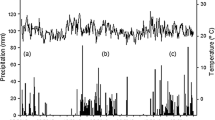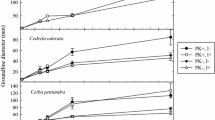Summary
The nitrogen budge of ‘rotational bush fallow’ agriculture (jhum) was investigated at higher elevations of Meghalaya in north-eastern India under 15, 10 and 5 year fallow cycles (the intervening fallow period between one or two croppings on the same site). Nitrogen depletion was affected by initial stocks in the soil and vegetation compartment at the time of slash and burn as well as the rate at which this was lost during the subsequent land use. While nitrogen losses due to the burn was more severe under longer cycles compared to the 5 year cycle the losses through sediment and water was more under a 15 year cycle compared to 10 and 5 year cycles. Transfer of nitrogen from soil to the weed biomass increased with shortening of the fallow cycle. The positive role of weeds in conservation of nitrogen in their biomass and subsequent release through organic manure into the agriculture system has been highlighed. Under a short fallow cycle of 5 years, considered on a time scale of 15 years, the soil nitrogen was depleted to a very low level compared to a 15 year cycle, suggesting that a 5 year cycle as prevalent today is not viable from the point of view of nitrogen economy.
Similar content being viewed by others
References
Ahlgren I F and Ahlgren C E 1960 Ecological effects of forest fires. Bot. Rev. 26, 483–533.
Allen S E 1964 Chemical aspects of heather burning. J. Appl. Ecol. 1, 347–367.
Allen S E (Ed) 1974 Chemical Analysis of Ecological Materials. Blackwell Scientific Publication, Oxford.
Altieri M A and Whitcomb W H 1979 Manipulation of insect populations through seasonal disturbance of weed communities. Prot. Ecol. 1, 185–202.
Altieri M A, Van Schoonhoven A and Doll J D 1977 The ecological role of weeds in insect pest management systems: a review illustrated with bean (Phaseolus vulgaris L.) cropping systems. PANS 23, 195–206.
Brady N C 1982 Chemistry and the world food supply. Science 218, 847–853.
Buckman H O and Brady N C 1960 The Nature and Properties of Soil. Macmillan, New York.
Chacon J C and Gliessman S R 1982 Use of the ‘non-weed’ concept in traditional tropical agro-ecosystems in south-eastern Mexico. Agro-ecosystems 8, 1–11.
Cox G W and Atkins M D 1979 Agricultural Ecology, Freeman, San Francisco, pp 397–399.
Debell D S and Ralston C W 1970 Release of nitrogen by burning light forest fuels. Soil Sci. Soc. Am. Proc. 34, 936–938.
FAO 1974 Fertilizers, the first decade: A Summary of results achieved between 1961 and 1971. FAO, Rome.
Gliessman S R 1980 Some ecological aspects of traditional agricultural practices in Tabasco, Mexico: Application for production. Biotica 5, 93–101(In Spanish, English Summary).
Gliessman S R 1982 Nitrogen distribution in several traditional Agro-ecosystems in the humid tropical lowlands of south-eastern Mexico. Plant and Soil 67, 105–117.
Gliessman S R, Garcia S R and Amador A M 1981 The ecological basis for the application of traditional agricultural technology in the management of tropical agro-ecosystems. Agro-ecosystems 7, 173–185.
Knight H 1966 Loss of nitrogen from the forest floor by burning. For. Chron. 42, 149–152.
Mishra B K and Ramakrishnan P S 1981 The economic yield and energy efficiency of hill agro-ecosystems at higher elevations of Meghalaya in north-eastern India. Acta. Oecologica/Oecologia Applicata 2, 369–389.
Mishra B K and Ramakrishnan P S 1982 Energy flow through a village ecosystem with slash and burn agriculture in north-eastern India. Agric. Systems 9, 57–72.
Mishra B K and Ramakrishnan P S 1983 Slash and burn agriculture at higher elevations in north-eastern India. I. Sediment, water and nutrient losses. Agric. Ecosystems Environ. 9, 69–82.
Mishra B K and Ramakrishnan P S 1983 Slash and burn agriculture at higher elevations in north-eastern India. II. Soil fertility changes. Agric. Ecosystems Environ. 9, 83–96.
Mishra B K and Ramakrishnan P S 1983 Secondary succession subsequent to slash and burn agriculture at higher elevations of north-east India. II. Nutrient cycling. Acta Oecologica/Oecologia Applicata 4, 237–245.
Nye P H and Greenland D J 1960 The soil under shifting cultivation. Tech. Comm. No. 51, Comm. Bur. Soils, Harpenden.
Ramakrishnan P S and Mishra B K 1981 Population dynamics ofEupatorium adenophorum Spreng. during secondary succession after slash and burn agriculture (jhum) in north-eastern India. Weed Res. 22, 77–84.
Ruthenberg H 1976 Farming Systems in the Tropics. Clarendon Oxford, p. 366.
Sanchez P A, Bandy D E, Villachica J H, Nicholaides J J 1982 Amazon basin soils: management for continuous crop production. Science 216, 821–827.
Saxena K G and Ramakrishnan P S 1983 Herbaceous vegetation development and weed potential in slash and burn agriculture (Jhum) in north-eastern India. Weed Res. (In press).
Toky O P and Ramakrishnan P S 1981 Cropping and yields in agricultural systems of the north-eastern Hill region of India. Agro-ecosystems 7, 11–25.
Wells C G 1971 Effects of prescribed burning on physical properties of soil.In Prescribed burning Symposia, U.S.D.A., For. Serv. South-Eastern For. Exp. Stn., Asheville, NC, pp. 80–97.
White E M, Thompson W W and Gartner F R 1973 Heat effects on nutrient release from soils under ponderosa pine. J. Range Manage. 22, 22–24.
Author information
Authors and Affiliations
Rights and permissions
About this article
Cite this article
Mishra, B.K., Ramakrishnan, P.S. Nitrogen budget under rotational bush fallow agriculture (jhum) at higher elevations of Meghalaya in north-eastern India. Plant Soil 81, 37–46 (1984). https://doi.org/10.1007/BF02206892
Received:
Revised:
Issue Date:
DOI: https://doi.org/10.1007/BF02206892




